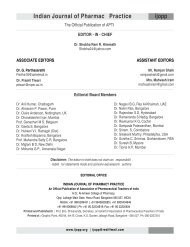Jul-Sep, 2012 - Indian Journal of Pharmacy Practice
Jul-Sep, 2012 - Indian Journal of Pharmacy Practice
Jul-Sep, 2012 - Indian Journal of Pharmacy Practice
Create successful ePaper yourself
Turn your PDF publications into a flip-book with our unique Google optimized e-Paper software.
Munsab Ali - Associated socioeconomic status with illness behavior in tuberculosis patients undergoing DOTS therapy23reasons for their frustration and dissatisfaction. Thus, illnessbehaviour is inversely related to income per month.CONCLUSIONThe present study concludes that the illness behavior is mostprominent in male gender patients. Frequency <strong>of</strong> tuberculosiswas found to be decreased very rapidly as the degree <strong>of</strong>education increases and was zero in case <strong>of</strong> postgraduates.Occupation status has a great role in illness behavior as thelow occupation status triggers the obsession. The per capitaincome <strong>of</strong> an individual has great impact on his social status aswell as satisfaction. Thus, socioeconomic status has atremendous role in illness behaviour <strong>of</strong> tuberculosis patientsundergoing DOTS therapy.ACKNOWLEDGMENTSAuthors are highly thankful to medical and DOTS providerand social workers <strong>of</strong> the DOTS Centre for their enthusiasticcooperation. We are also thankful to Mr. Brijesh for hisvaluable contribution and Sanjay Saroj, Babita for theirsecretarial help. We are very grateful to the projectcoordinator and staff <strong>of</strong> all the centers <strong>of</strong> LRS Institute fortheir full cooperation and support.REFERENCES1. Dye C, Scheele S, Dolin P, Pathania V, Raviglione MC.Consensus statement. Global burden <strong>of</strong> tuberculosis:estimated incidence, prevalence and mortality by country. WHOGlobal Surveillance and Organization project. JAMA 1999;282:677-86.2. Epidemiology, strategy, financing: WHO report, Geneva: WorldHealth Organization; 2009 (WHO/HTM/TB/2009.411).3. RNTCP Communication Strategy for a health. Published byCentral TB Division Directorate General <strong>of</strong> Health ServiceMinistry <strong>of</strong> Health and Family Welfare Government <strong>of</strong> India,2008.4. Global Tuberculosis Control Report 2009, Available from; URL.http: //www.who.int/tb/ Publications/ global_report/2009/pdf/full_ report. Pdf. Accessed November 30, 2009.5. http://www.tbcindia.nic.in/pdfs/TB%20India%202009.pdf.6. Chauhan, L.S, Agarwal, S.P. Revised national TuberculosisControl Programme. Tuberculosis in India chapter 3, 2008: 23-34.7. Tones K. Health education, behaviour change and publicrdhealth. Oxford textbook <strong>of</strong> public health (ed. 3 ), vol 2, NewYork: Oxford University Press, 1997: 786.8. Rabin D, Schach E. Medicaid, Morbidity and Physician. MedicalCare 1975; 13:68-73.9. Yee D, Valiquette C, Pelletier M, Parisien I, Rocher I, Menzies D.Incidence <strong>of</strong> serious side effects from first- line antituberculosisdrugs among patients treated for active tuberculosis. Am JRaspir Crit Care Med 2003; 167:1472-7.10. Yamada S, Caballero J, Matsunaga DS, Agustin G, Magana M:Attitudes regarding tuberculosis in immigrants from thePhilippines to the United States. Fam Med 1999; 31:448-77.11. Peterson TJ, Castle White M, Young JA, Meakin R, Moss AR:Street talk: knowledge and attitudes about tuberculosis andtuberculosis control among homeless adults. Int J Tuberc LungDis 1999; 3:528-33.12. Babcock DE and Miller MA. Client Education: Theory andpractice. Baltimore: Mosby Year Book Inc.; 1994.13. Kunik ME, Roundy K, Veazey C, et al. Surprisingly highprevalence <strong>of</strong> anxiety and depression in chronic breathingdisorders. Chest 2005; 127(4):1205-11.14. Aydin IO, Ulusahin A. Depression, anxiety, comorbidity anddisability in tuberculosis and chronic obstructive pulmonarydisease patients: Applicability <strong>of</strong> GHQ-12. Gen Hos Psych2001; 23(2):77-83.15. Dubey KK, Bhasin SK, Bhatia MS. Psychological reactionsamongst patients, their familymembers and the communityregarding hospitalized tuberculosis patients in Delhi.Psychiatry Today 1998; 11:30-3.16. Moudgil AC, Persadh D. Psychosocial survey <strong>of</strong> tuberculosispatients in a sanatorium. <strong>Indian</strong> J Tub 1972; 19:34-7.17. Natani GD, Jain N.K, Sharma TN et al. Depression intuberculosis patients: correlation with duration <strong>of</strong> disease andresponse to anti-tuberculous chemotherapy. <strong>Indian</strong> <strong>Journal</strong> <strong>of</strong>Tuberculosis 1985; 32(4):195-8.18. Lorant V , Deliège D, Eaton W, Robert A, Philippot P, AnsseauM. Socioeconomic Inequalities in Depression: A Meta-Analysis.American <strong>Journal</strong> <strong>of</strong> epidemiology 2002; 157:98-112.19.20.Marmot M, Feeny A. General expression for social inequalitiesin Health. IARC Sci Public 1997; 38:207-8.Prescott E, Vestbo J. Socio economic status and chronicobstructive pulmonary disease. Thorax 1999; 5:737-41.21. Akhtar S, White F, Hassan R et al. Hyperendemic pulmonarytuberculosis in peri-urban areas <strong>of</strong> Karachi, Pakistan. BMCPublic Health 2007; 3(7):70.22. Bobbin, C. Pathological Basis <strong>of</strong> Disease, New York,Saunders.1984.23. Arora VK, Johri A, Verma RP. Post treatment adjustment problemand coping mechanism in pulmonary tuberculosis patients. IndJour Tub 1992; 39:181.<strong>Indian</strong> <strong>Journal</strong> <strong>of</strong> <strong>Pharmacy</strong> <strong>Practice</strong> Volume 5 Issue 3 <strong>Jul</strong> - <strong>Sep</strong>, <strong>2012</strong> 48
















